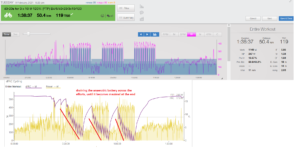Today’s file share is a session that many riders either love or loathe: 40:20s. These are also called a variety of other names including 30:30s, 30:15s, short shorts, Tabatas, Ronnestad intervals, or generically HIIT training.
In these sessions you do a series of short intervals above FTP (40 seconds), with a brief respite between them (20 seconds). You do 10 of these in a row, so the set lasts 10 minutes. You repeat this 2-4 times. You can vary the interval recovery time frame and ratio. So there are many different versions of this type of set.
They are designed to be a VO2 max set. That is, they are generally programmed at around 120%+ of FTP, but of course this varies between athletes. The idea is that across the 10 minutes of the set you deplete your anaerobic battery such that by the second half of the interval you move into VO2 max territory. Many athletes find them more tolerable than a traditional VO2 max set of say 6 x 3 minutes at 120% with a 1:1 work to rest ratio.
The key with these is the depletion of the anaerobic battery. The top picture shows you a set of these being done using a TrainingPeaks file. The blue is my workout build and the purple is the rider’s power. Looks like a well executed set.
The second picture demonstrates how the WKO5 analytics program models the same workout. The purple line is modeling the rider’s anaerobic battery as it depletes across the 10 minutes of the set. I have marked this with a red line. This is exactly what we want to see. By the time the rider gets to the last 40 seconds they should be hanging on by a thread. And this rider is.
You can also see how the 5 minutes between the sets is not quite enough for the anaerobic battery to completely re-generate and the rider starts set 2 with a slight deficit. That makes the second set harder, and this is repeated again in the 3rd set. Again, exactly what we want to see.
Overall, a very well executed set of 40:20s. But, and here is the big question: are these more effective than a traditional set of consistent VO2 max intervals? In my experience these types of workouts are actually providing a different type of stimulation. They are both grouped in the category of VO2 max sets, but athletes respond to them differently. What works for one athlete may not work for another.
The role of the coach/scientist is to diagnose this, so that they may program accordingly.
